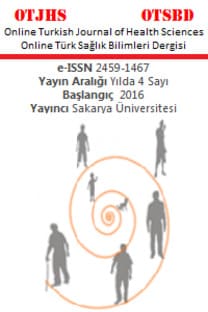Karpal Tünel Sendromu Tanılı Erkek Olguların Klinik ve Elektrofizyolojik Bulgularının Meslek Hastalığı, Obezite ve Sigara Kullanımıyla İlişkisinin Değerlendirilmesi
karpal tünel sendromu, erkek, meslek hatalıkları, obesite, sigara
Clinical and Neurophysiological Evaluation of the Male Patients with Carpal Tunnel Syndrome with Regard to Relationship among Occupational Disease, Obesity and Smoking
carpal tunnel syndrome, male, obesity, occupitional diseases, smoking,
___
- Burke DT, Burke MM, Stewart GW, Cambre A. Splinting for carpal tunnel syndrome: insearch of the optimal angle. Arch Phys Med Rehabil. 1994;75:1241-4.
- Provinciali L, Giattini A, Splendiani G, LogulloF. Usefulness of hand rehabilitation after carpal tunnel surgery. Muscle Nerve. 2000;23:211-6.
- Palmer KT, Harris EC, Coggon D. Carpal tunnel syndrome and its relation to occupation: a systematic literature review. Occup Med. 2007;7(1):57-66.
- Pickering SA, Stevens A, Davis TR. Work practices and histopathological changes in the tenosynovium in carpal tunnel syndrome in men. Journal of Hand Surgery. 2004;29(4):325-8.
- Watts AC, McEachan J, Carpal tunnel syndrome in men. Current Orthopaedics. 2006;20(4):294–298.
- Shiri R, Pourmemari MH, Falah-Hassani K, Viikari-Juntura E. The effect of excess body mass on the risk of carpal tunnel syndrome: a meta-analysis of 58 studies. World Obesity. 2015;16(12):1094–1104.
- Pourmemari MH, Juntura EV, Shiri R. Smoking and carpal tunnel syndrome: A meta-analysis. Muscle Nerve. 2014;49(3):345–350.
- Sezgin M, Incel NA, Serhan S et al. Assessment of symptom severity and functional status in patients with carpal tunnel syndrome: reliability and functionality of the Turkish version of the Boston Questionnaire. Disabil Rehabil. 2006;28(20):1281-5.
- Okutsu I, Ninomiya S, Hamanaka I, Kuroshima N, Inanami H. Measurement of pressure in the carpal canal before and after endoscopic management of carpal tunnel syndrome. The Journal of Bone and Joint. Surgery. 1989;71(5):679-683.
- Silverstein BA, Fan ZJ, Bonauto DK, et al. The natural course of carpal tunnel syndrome in a working population. Scand J Work Environ Health. 2010;36(5):384–393.
- Shiri R. A. square-shaped wrist as a predictor of carpal tunnel syndrome: A meta-analysis. Muscle Nerve. 2015;52(5):709-13.
- Heilskov-Hansen T, Mikkelsen S, Svendsen SW, et al. Exposure-response relationships between movements and postures of the wrist and carpal tunnel syndrome among Male and female house painters: a retrospective cohort study. Occupational Environmental Medicine. 2016;73(6):401-8.
- Bonfiglioli R, Mattioli S, Armostrong T, et al. Validation of the ACGIH TLV for hand activity in the OCTOPUS cohort: a two-year longitudinal study of carpal tunnel syndrome. Scand J Work Environ Health. 2013;39(2):155–163.
- Nathan PA, Istvan JA, Meadows KD. A longitudinal study of predictors of research-defined carpal tunnel syndrome in industrial workers: findings at 17 years. Journal of Hand Surgery. 2005;30:593–598.
- Fan ZJ, Harris‐Adamson C, Gerr F et al. Associations Between Workplace Factors and Carpal Tunnel Syndrome: A Multi-Site Cross Sectional Study .American Journal of Industrial Medicine. 2015;58:509–518.
- McDiarmid M, Oliver M, Ruser J, Gucer P. Male and Female Rate Differences in Carpal Tunnel Syndrome Injuries: Personal Attributes or Job Tasks? Environmental Research Section. 2000;83(1):23-32.
- Jason TG, Scott DM Anthony JW, Alan LC. Occupational and Biopsychosocial Risk Factors for Carpal Tunnel Syndrome. Journal of Occupational and Environmental Medicine. 2014;56 (9):965-972.
- Pourmemari MH, Heliövaara M, Viikari‐Juntura E, Shiri R. Carpal tunnel release: Lifetime prevalence, annual incidence, and risk factors. Muscle&Nerve. 2018;58(4) 497-502.
- Nathan PA, Keniston RC, Lockwood RS, Meadows KD. Tobacco, Caffeine, Alcohol, and Carpal Tunnel Syndrome in American Industry: A Cross-Sectional Study of 1464 Workers. Journal of Occupational & Environmental Medicine. 1996;38(3):290-298.
- Richardson JK, Jamieson SC. Cigarette smoking and ulnar mononeuropathy at the elbow. American Journal of Physical Medicine& Rehabilitation. 2004;83(9):730–734.
- ISSN: 2459-1467
- Yayın Aralığı: Yılda 4 Sayı
- Başlangıç: 2016
- Yayıncı: Oğuz KARABAY
Sibel ÜSTÜN ÖZEK, Canan EMIR, Rahsan İNAN
Mehtap BİNGÜL, Duygu SÖMEN BAYOĞLU, Tamay GÜRBÜZ, Pınar ALAGÖZ, Sebahat AKSARAY, Çağatay NUHOĞLU
Beyin Ölümü Tanısı Alan Hastaların Retrospektif Analizi
Youtube ve Astım: Astımla İlgili Popüler Videoların Bilgi İçeriğinin Eleştirel Bir Değerlendirmesi
Fatma Esra GÜNAYDIN, Sedat ALTIN
Ortodontiye İlişkin Dünya Genelindeki İnternet Verilerinin Değerlendirilmesi: Google Trends Analizi
Muhammed Hilmi BÜYÜKÇAVUŞ, Burak KALE, Hikmet ORHAN
Riskli Gebelerde Prenatal Bağlanma ve Risklerin Değerlendirilmesi
Ayça DEMİR YILDIRIM, Nevin ŞAHİN
COVID-19 Pozitif Hastaya Hemşirelik Bakımı Veren Bir Hemşirenin Deneyimleri: Olgu Sunumu
Canan BİRİMOĞLU OKUYAN, Elifnur GÜNEŞ, Esra YEŞİLYURT
Nanoteknoloji ve Nanobiyomalzemeler: Ağız Kanserini Yönetme Yollarını Yeniden Tanımlama
